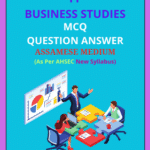Class 11 Business Studies Chapter 5 Emerging Modes of Business Question answers to each chapter are provided in the list so that you can easily browse through different chapters HS 1st Year Business Studies Notes, AHSEC Class 11 Business Studies Chapter 5 Emerging Modes of Business, AHSEC Class 11 Business Studies Question Answer In English Notes and select needs one.
Class 11 Business Studies Chapter 5 Emerging Modes of Business
Also, you can read the NCERT book Notes Class 11 Business Studies Chapter 5 Emerging Modes of Business online in these sections Solutions by Expert Teachers as per AHSEC Class 11 Business Studies Chapter 5 Emerging Modes of Business (CBSE) Book guidelines. These solutions are part of AHSEC All Subject Solutions. Here we have given Assam Board Class 11 Business Studies Chapter 5 Emerging Modes of Business Solutions for All Subjects, You can practice these here NCERT Class 11 Business Studies Chapter 5 Emerging Modes of Business.
Emerging Modes of Business
Chapter: 5
VERY SHORT TYPE QUESTIONS ANSWERS (1 MARK EACH)
A. Multiple Choice Question:
1. e-commerce does not include
(a) A business’s interactions with its suppliers.
(b) A business’s interactions with its customers.
(c) Interactions among the various departments within the business.
(d) Includes among the geographically dispersed units of the business.
Ans: (c) Interactions among the various departments.
2. Outcoming –
(a) Restricts only to the contracting out of Information Technology Enabled Services (ITES)
(b) Restricts only to the contracting out of non-core business processes.
(c) Includes contracting out of manufacturing and R & D as well as service processes both core and non-core but restricts only to domestic territory.
(d) Includes off-shoring.
Ans: (c) Includes contracting out of manufacturing and R & D as well as services processes – both core and non-core- but restricts only to domestic territory.
3. The payment mechanism typical to e-business.
(a) Cash on Delivery (COD).
(b) Cheques.
(c) Credit and Debit cards.
(d) e-cash.
Ans: (c) Credit and Debit cards.
4. A e-call centres handles:
(a) only in-bound voice based business.
(b) only out-bound voice based business.
(c) Both voice -based and non-voice based business.
(d) Both customer facing and back end business.
Ans: (d) Both customer facing and back end business.
5. It is not an application of e-business.
(a) Online bidding.
(b) Online procurement.
(c) Online trading.
(d) Contract R & D.
Ans: (d) contract R & D.
Short Answer Questions
1. State any three differences between e-business and traditional business.
Ans: Following are the differences between ebusiness and traditional business:
(i) Traditional business is difficult to establish, but e-business is simple.
(ii)Traditional business requires physical pressure and e-business does not require.
(iii) Cost of selling up of traditional business is high and in case of e – business the cost of setting up is low as no requirement of physical facilities.
2. How does outsourcing represent a new mode of business?
Ans: The basic aim of globalisation is the greater integration of national economics all over the world into one single market. The perceptions of the employee about the BPO has to change from being a life style to a career option. One way of doing this is to re-constant the organisation structure. The chances to climb the corporate leader should be made to look bright. In the present day the options that a BPO employee has in climbing up the corporate ladder. BPO firm can complete the process more efficiently leaving the original firm free to concentrate on its core competency, BPO is the act of transferring some of an organisation repeated non-core and core business processes to an outside provider to achieve cost reduction. So, it represents a new node of business.
3. Describe briefly any two applications of e-business?
Ans: E-business means business done online. It provides ways to exchange information between individuals, companies and countries and most important of all, between computers.
Firstly, using the net one can (both customer and producer) directly approach the suppliers and customers, cutting down the level of intermediation and as well as cutting down the costs.
Secondly, Internet tools like enterprise resource planning (ERP), Supply chain Management (SRM), and customer relationship management (CRM) can easily be deployed over the net permitting amazing efficiency in time needed to market, customer loyalty, on-time delivery and eventually profitability.
4. What are the ethical concerns involved in outsourcing?
Ans: In case of outsourcing, many business may cut their cost by using child labour/women labour in the factories at minimum wages. Which is the violation of factories Act 1948 and the minimum payment of wage Act.
Moreover, wage-discrimination on the basis of sex of other worker may be emerged also in the outsourcing business activities.
On the other hand, in the interest of earning commercial profit, the business concern can involved with its various outsourcing unit by unfair means:
5. Describe briefly the data storage and transmission risks in e-business.
Ans: Infact, data and information is power for the business. Of course, if these data and information are recorded wrongly then it will be risky for the business as well as customer. Some valuable data and information may be stolen as modified for unfair privileges and purposes.
Moreover, data and information may be intercepted during the time of transmission. In case of data storage and transmission another risk is virus and hacking. Virus implies “Vital Information Under Siege. Virus is a programme that replicates itself on the other computer systems. The effect of virus computer may range from more annoyance in terms of some on screen display (Level 1 virus), disruption of functioning (Level 2) virus) damage to target data files (level 3 virus) to complete destruction of the system (Level 4 virus).
Long Answer Questions
1. Why are e-business and outsourcing referred to as the emerging modes of business? Discuss the factors responsible for the growing importance of these trends.
Ans: E-Business has already proved its potential across the world. In fact, it has come to be described as the biggest development in the field of commerce. Since the invention of money Electric commerce has become a jargon for business over the part few years with increased awareness about the use of computer and communication technologies to simplify business procedures and increase efficiency. Powered by the break through in it (infuriation technology) and telecom and the rapid growth of the internet, e-commerce is already changing the way people work, buy and hire. According to fortune magazine it is the foundation of new industrial order. It will change the relationship between consumers and producers in ways more profound than one can yet imagine. E-commerce has created an electronic revolution the impact of which on the economy is much more intense than that caused by the industrial revolution. The role of internet in the evolution of E-commerce has been so crucial that the history of e-commerce will remain incomplete without the inclusion of the history of internet. Using the internet, one can communicate with other people throughout the world by means of e-mail, read online various of news papers, magazines, academic journals and books, join discussion groups on almost all conceivable topic, participate in games and obtain free computer software. In recent years, internet has allowed commercial enterprises to connect with one another and with customer. Today, all kind of business provide information about their products and services on the internet. Many of these business use the internet to market and sell their products and services. The part of the internet known as the World Wide Web (WWW) or more simply, the web is a subset of the computers on the internet that connected in a specific way making their contents easily accessible to each other. The most important thing about the web is that it includes an ease-to-use standard interfere. This interference makes it possible for people who are not computer experts to use the web to access a variety of internet resources. Thus, internet is a world wide network of networks which helps dissimilar computers with different operating systems to communicate with each other using a standard set of protocols. All computers within any network are connected to each other with the help of cables. The message travels across the network with the help of networking protocols. A Protocol is a set of rule which computer use to communicate with each other across a network. So, e- business referred to as the emerging modes of business.
2. Elaborate the steps involved in on-line trading.
Ans: Following are the main steps involved in online trading:
(i) Registration: Registration is the first step in online trading. For that purpose the customer is to fill up a registration form. In order to register the name, the customer is to open an account with the online vendor. All information to be filled up in the form will be in the password relating to the accounts of customer.
(ii) Placing order: The customer thereafter may pick and drop the items in the shopping cost. The shopping cost is an online record, where the customer is pick up while borrowing the online store. It is same like in physical store a customer can put in and take items out of the cost.
(iii) Payment: In this step the customer is to pay the amount price of his goods. There are main five ways of payment in online trading.
(a) Cash on Delivery.
(b) Cheque.
(c) Net-banking transfer.
(d) Credit or Debit.
(e) Digital card.
3. Discuss the salient aspects of B2C commerce.
Ans: Following are the salient aspects of B2C Commerce:
(i) It is done in between business organisation and the ultimate customer.
(ii) It is implemented in time of selling the goods.
(iii) It includes all promotional, selling and distribution activities.
(iv) In this aspect of e-commerce electronic payment, ATM etc, are used.
(v) In this aspect, customer can use various call centres set up by companies to make too free calls to make queries and lodge complaints round the clock at no extra cost to them.
4. Discuss the limitations of electronic mode of doing business. Are these limitations serve enough to restrict its scope? Give reasons for your answer.
Ans: Following are the limitations of electronic mode of doing business:
(i) Return on-investment in the form of cost and benefits have been hard to quantity in E-commerce. In traditional business, the return on investment before committing to any technology is often calculated. But, it is difficult to do with e-commerce because costs can change dramatically during short lived e-commerce implementation periods due to the rapid change in technologies.
(ii) Many business firms find it troublesome in recruiting and retaining employees with adequate technological background and skills needed to create an effective e-commerce atmosphere.
(iii) Difficulty of integrating databases and transaction -processing software designed for transforming traditional commerce into a software that enables e-commerce.
(iv) Cultural and legal obstacles in conducting e-commerce: Some customers in our country are still some what reluctant to send their credit card numbers over the internet. Other customers are simply resistant to change and are uncomfortable in viewing merchandise on a computer screen rather than in person.
(v) On the set of problems of E-commerce in India –
(a) Regulatory problems.
(b) Infrastructural problems.
(c) Commercial problems.
(d) Low confidence.
(e) Problem of lacking.
These limitations are not enough to restrict its scope because of the reasons that in spite of having these limitations following advantages are associated with the electronic mode of doing business.
(i) 24×7 operations: Round the clock operation is possible and natural in E-Business. While it is an impossible and expensive proposition in traditional business.
(ii) Global Reach: The net being inherently global assessing the global market and reaching global customers is relatively easy on the net compared to the world of bricks
(iii) Cost of acquiring, serving and retaining customers: It is relatively less costly to acquire new customers over the net. Due to 24×7 operation and its global accessibility, it is also possible to help reduce business costs, marketing costs, channel costs, communication and promotional costs, ultimately retain customers’ loyalty with minimal investment.
(iv) An extended enterprise is easy to build: Internet provides an effective, less expensive way to extend the activities of our enterprise all the way with suppliers, distributors, retails and ultimately with house-hold end-customers.
(v) Intermediation can be avoided: Using the net one can (both customer and producer) directly approach the supplier and customer, cutting down the level of intermediation and as well as cutting down the costs.

Hi, I’m Dev Kirtonia, Founder & CEO of Dev Library. A website that provides all SCERT, NCERT 3 to 12, and BA, B.com, B.Sc, and Computer Science with Post Graduate Notes & Suggestions, Novel, eBooks, Biography, Quotes, Study Materials, and more.






